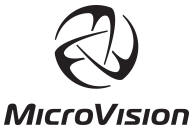PROSPECTUS SUPPLEMENT SUMMARY
The following summary is qualified in its entirety by, and should be read together with, our consolidated financial statements and related notes thereto and the more detailed information appearing elsewhere or incorporated by reference in this prospectus supplement and the accompanying prospectus. Before you decide to invest in our common stock, you should read the entire prospectus supplement and the accompanying prospectus carefully, including the risk factors and the financial statements and related notes included or incorporated by reference in this prospectus supplement and the accompanying prospectus.
Our Company
Overview
MicroVision, Inc. is developing a lidar sensor to be used in automotive safety and autonomous driving applications. Our lidar sensor uses our pioneering laser beam scanning (LBS) technology. Our LBS technology is based on our patented expertise in systems that include micro-electrical mechanical systems (MEMS), laser diodes, opto-mechanics, electronics, algorithms and software and how those elements are packaged into a small form factor. Our lidar sensor also utilizes edge computing and machine intelligence as part of the solution. Though automotive lidar is our priority now, we have also developed solutions for Augmented Reality (AR), Interactive Displays, and Consumer Lidars.
We are developing our 1st generation lidar sensor, which we call Long Range Lidar (LRL), for OEM and Tier-1 automotive suppliers to be incorporated into automotive active collision avoidance systems and autonomous driving vehicles. This product will also be targeted for sales to technology companies focused on Mobility as a Service (MaaS). MaaS customers are currently major users of automotive lidar sensors.
We believe our technology and designs for automotive lidar can be successful in the market and expect our solutions to have features and performance that exceed market needs and competitive products and will provide us several sustainable strategic advantages in the market. In April 2021 we completed our A-Sample LRL module. The A-Sample could be used for demonstration to interested parties. Following completion of the A-Sample hardware we will work to internally verify all features perform as expected. In addition to verification, we will conduct reliability and compliance testing. It is possible the 1st Generation LRL could be available for sale, in small quantities, in the third or fourth quarter of 2021.
In addition to our automotive lidar sensor, we have developed micro-display concepts and designs that could be utilized in head-mounted AR headsets and have developed a 1440i MEMS module that can support AR headsets. We have also developed a display solution targeted at the smart speakers market, which we call an Interactive Display module. This display is designed to project onto a countertop, tabletop or a wall from inside a smart speaker. The user can then touch the projected image on any surface on which the display is visible and it will behave like a touchscreen, as on a tablet or smartphone. Lastly, we have developed a small lidar sensor, which we call Consumer Lidar, for use indoors with smart home systems. This allows for a smart home system to understand what is happening in the home and then enable the smart home to respond in an appropriate way.
For the past few years, our strategy has been to sell AR displays or components, Interactive Displays, or Consumer Lidars to OEMs and ODMs for incorporation into their products. However, while we do have a well-known customer for one of these products which generates royalty income, the volume of sales and resulting royalties from that product are not significant, and we have been unable to secure additional customers to launch one of our products.
As a result, since February 2020, we have been seeking strategic alternatives, including a potential sale or merger of the Company, sale of part of the Company, strategic minority investment, as well as licensing and other transactions, while continuing to develop our 1st Generation Long Range Lidar module. We currently have no agreements or commitments to engage in any specific strategic transactions, and our exploration of various strategic alternatives may not result in any specific action or transaction. We may be unable to identify, successfully negotiate with and consummate a suitable transaction with a buyer or other strategic partner on favorable terms, on the timeline we expect, or at all. If we determine to engage in a strategic transaction, we cannot predict the impact that such a transaction might have on our operations or stock price, and we cannot predict the impact on our stock price or operations if we fail to enter into such a transaction.
